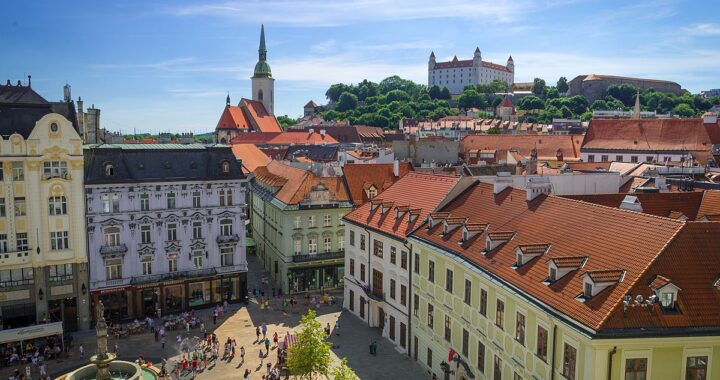Unknown Slovakia
Usually, one has a perception of the country one is visiting without having to Google first. This wasn’t really the case for me with Slovakia. The country hasn’t existed for very long. It peacefully separated from the Czech Republic in 1993, having previously existed as Czechoslovakia during the interwar period and then since the end of World War II.
There are now around five million people living in Slovakia. The country is relatively prosperous, thanks in the first place to a thriving auto industry. Volkswagen, PSA Peugeot Citroën, Kia, Jaguar Land Rover, and Volvo all have assembly plants in Slovakia. The country has been a member of the Eurozone since 2009.
Corruption is still a problem there, as it is in all former Soviet countries. In the Corruption Perceptions Index 2022 by Transparency International, the country scores 53. The score ranges from 0, completely corrupt, to 100, no corruption at all. Slovak journalist Jan Kuciak found out the hard way not to meddle too much in corruption issues. He was murdered in 2018, along with his girlfriend. Kuciak was then investigating links between the Italian mafia and Slovak politics. This involved, among others, the then-social democratic Prime Minister Robert Fico. He only resigned after persistent protests against his rule. Kuciak’s murder remains unsolved. The alleged instigator, businessman Marian Kočner, has been acquitted twice in court due to lack of evidence. Fico is now a member of parliament.
In response to Kuciak’s murder, Slovaks elected a liberal pro-European president, Zuzana Caputova, in 2019. She recently announced that she would not run for a second term in 2024. The presidency in Slovakia is primarily a ceremonial role, although the president is nominally the commander-in-chief of the military.
Getting to Bratislava is not easy
Bratislava has been on my to-do list since 2019. In addition to the coronavirus and the war in Ukraine, there was another reason I haven’t been to Bratislava yet. There are no direct flights to Bratislava from Brussels or Amsterdam. Nor from Athens or Sofia, the previous destinations on my European trip. To get to Bratislava, it’s necessary to take a small detour.
This detour involves going through the Austrian capital, Vienna. Vienna and Bratislava are just over an hour’s drive apart. Many trains run daily between the two capitals. Unfortunately, there are no direct trains from Vienna Airport (pictured) to Bratislava. You have to take a train from the airport to Vienna Central Station, then catch a train to Bratislava. This is cumbersome. Fortunately, there is an alternative: the bus.
Several international bus companies run direct routes from Vienna Airport to Bratislava. This journey also takes just over an hour. Flixbus even operates services to three different locations in Bratislava. I have chosen the central bus station as my final destination. The Flixbus runs every hour.
My return trip from Bratislava to Brussels Zaventem on Wednesday, September 13th will also follow the Vienna route. Hopefully, Austrian Airlines will transport me safely to and from Vienna.
Two days in Bratislava
Of course, the primary goal of my trip to Bratislava is to interview a person or persons with a disability who live and thrive in the city. Such an interview typically takes half a day, including travel time. This leaves me about a day and a half to explore the city. For global cities like Paris, London, or Berlin, a day and a half would certainly be insufficient. For Bratislava, however, it seems just right.
The old town of Bratislava, Stare Mesto, is a must-see. Not least because the Ibis hotel where I will be staying is located just a five-minute walk away from the old town. I’m sure I’ll also be drawn to Bratislava Hrad, the castle. Whether I will actually visit it depends on its accessibility. Buildings on hills aren’t typically easy to reach on foot, as I remember from the Prague Castle.
According to this page on Visit Bratislava, the city should generally be quite accessible for people with physical disabilities. Only some streets in the old town still have cobblestones. Not ideal if you’re in a wheelchair, but also not if you are mobile but have difficulties with walking. However, cobblestones don’t bother me. After more than 17 years of living in historic Antwerp, I am accustomed to them.
There are more things to do in Bratislava, according to this page with tips by journalist Esther de Beer. Time will tell what I might end up doing. In any case, in September it will be too soon for the Christmas market …
Call to people in Bratislava
I’m still looking for a person or persons who would be willing to grant me an interview about his/her/their life in Bratislava. How do you experience living with a disability in the Slovak capital with regard to, for instance, work/free time/transport/finances? I would love to hear it from you during a personal interview. See this page for details on how to contact me and when the interview should take place. The type of disability is not important, as long as you are able to communicate clearly in English.


